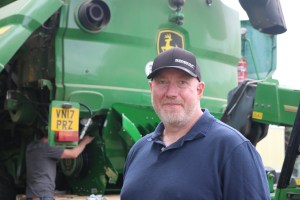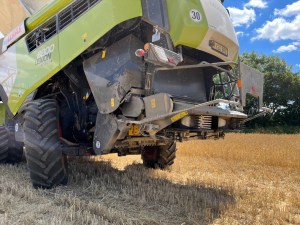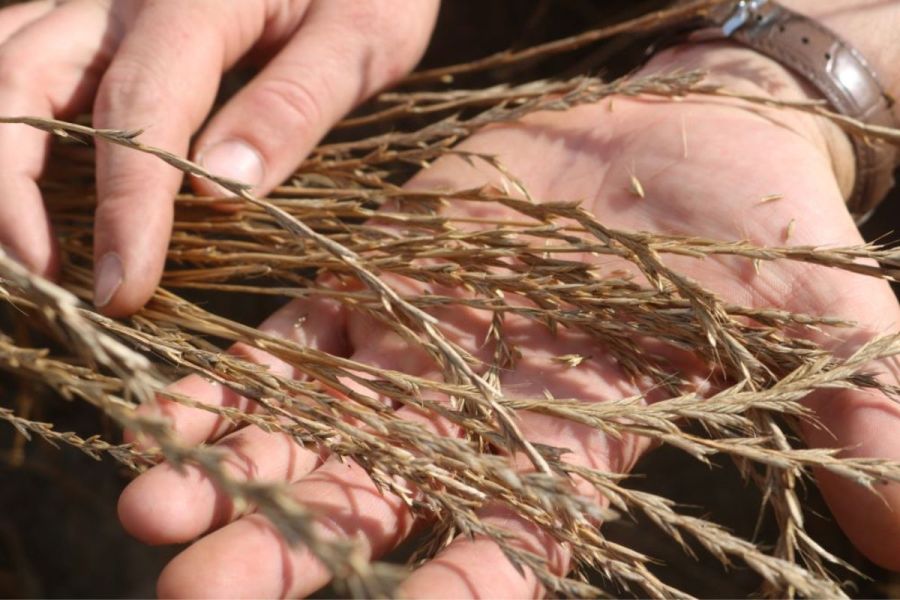During a particularly intense year for grassweed pressure, what learnings can be shared by three growers who’ve been investigating a novel method of control at harvest? CPM finds out.
“HWSC is a seven to 10 year weed seedbank reduction technique, it’s not an instant fix.”
By Janine Adamson
Although well-proven across the pond, harvest weed seed control (HWSC) is yet to take off in the UK despite offering an alternative, non-chemical solution.
Recognising its potential, three farmers supported by industry experts have been trialling the concept which is based around Redekop’s seed control unit (SCU). Coming together to discuss and compare findings, the group agrees that although further work is required, HWSC is a much-welcomed development.

HWSC is part of Adam Driver’s vision for weed control plus inter-row hoeing and targeted spot spraying.
In support, Suffolk-based Adam Driver says all farmers understand the solution to grassweeds doesn’t, and never will, come from a chemical can. “HWSC and the SCU are part of my personal vision for weed control plus inter-row hoeing and targeted spot spraying. It’s taking an integrated approach to weed management while utilising novel technologies.”
But what is HWSC? It’s a concept based on the theory that if you hit a weed seed hard enough four times, it becomes unviable. The chaff stream is then separated from the straw and passes into the SCU which is fitted below the straw chopper on the combine.
Independent trials show it’s effective in its methodology, killing up to 98% of the weed seed which it receives. As a result, the concept piqued the interest of the British On-Farm Innovation Network (BOFIN) and NIAB, which is how the UK farmer-led trials began.
To start the work, Adam, joined by Jake Freestone and Ted Holmes, were tasked with trialling the Redekop SCU on their own farms for Harvest 2022. Following analysis, the results are in and shine a positive light on HWSC and the SCU.
Adam, who operates a CLAAS Lexion 8800, says his main weed challenge is controlling blackgrass build-up in the chaff lines of his controlled-traffic farming system. “Unfortunately we have a huge blackgrass seedbank but the results show the SCU retained 54% of the seed in our harvested winter wheat, so it has to have helped.
“It’s also had a good effect on meadow brome when it occurs across the field as a whole rather than just the headlands,” he says. “It’ll be intriguing to compare these results with those of this season, which has been especially bad for grassweed pressure.”
Whereas blackgrass is Adam’s biggest headache, Ted finds Italian ryegrass more of a concern on the farm he manages in North Warwickshire on behalf of Velcourt. With a New Holland CR9.90 combine fitted with the SCU, he achieved a 60% reduction of the weed in winter barley and 44% reduction in spring barley.
Ted says because this year’s weather has been a perfect season for a grassweed explosion, and given the success of the SCU so far, he plans to stick with it. “In this year’s spring barley, which has followed a crop of winter wheat, you can already see where the SCU was running alternately on and off across the field, and an associated reduction in ryegrass plant numbers.

Trevor Thiessen says Redekop’s goal is to improve the SCU, paying attention to noise reduction and the unit’s size.
“Over time, I want to see that we’re reducing the ryegrass seedbank within our soils. Knowing where the seedbank is within the profile is critical, and this will impact my decision making for autumn cultivations. Where I have to, I will, and am, still using rotational ploughing where it’s appropriate to hit that reset button.”
Keith Challen from Belvoir Farming Company has also been investigating HWSC. In an innovative move, he applied pod sealant to an area of his crop with the aim of reducing weed seed drop in a bid to increase the volume entering the SCU.
“You can lose more than 60% of blackgrass seed before the combine even goes through the crop, so I’m intrigued to see if this works,” says Keith. “It could be a cost-effective way of boosting the SCU success rate, working hand-in-hand.
“Because it only lasts for a relatively short amount of time, it’s finding the sweet spot – applying it as late as possible before the weed seed is shed,” he says.
Discussions among the group also explore whether the SCU is successful at controlling cereal volunteers, with all in agreement that it is, particularly for wheat in malting barley. As a result, Adam raises the wider benefits of the SCU in terms of SFI payments.
“If you consider growing a wheat crop after oats, minimising the green bridge and therefore reducing aphid-vectored BYDV could mean no insecticide use. Receiving the associated SFI payment for this could make a difference,” he says.
They also agree that practically speaking, the SCU was relatively issue-free other than the impact of the unit’s width on combine manoeuvrability. For those who did experience minor niggles, their local dealerships were on hand to rectify them.
Redekop’s Trevor Thiessen says development work is now taking place to make the unit even more UK market-appropriate. “The goal is to improve the SCU, paying particular attention to noise reduction and potentially the size.
“We believe in supporting the local dealership network when launching an innovation such as this because there are many learnings to be taken from using the SCU in a practical on-farm environment,” he says.
“This is why the research with these growers is so important, to answer the question of where the SCU will provide benefit, but equally important as to where it may not be a fit. Each region of the world has different challenges related to managing their weeds at harvest and the UK is no exception.”

The seed control unit (SCU) is fitted below the straw chopper on the combine.
The group will continue to trial HWSC and the SCU for Harvest 2023 supported by a group of 50 ‘Seed Scouts’ recruited and overseen by BOFIN. The purpose is to conduct a nationwide survey of grassweeds left standing at harvest, sending samples to NIAB for analysis.
NIAB’s Will Smith says the only way HWSC will work is if the seeds are available to the machinery at harvest. “We currently know little about how much viable seed goes into the combine – there’s very limited work on this in the UK and Europe,” he says.
“However, it’s encouraging to see industry partnering with farmers to help address the problem through a creative, cultural solution.”
The Seed Scouts have each been allocated one of three sampling methodologies depending on their familiarity with trial protocols. The aim is to gain a wide farmer-supported data set, although the group acknowledges this may take time.
“HWSC is a seven to 10 year weed seedbank reduction technique, it’s not an instant fix,” says Keith. “The skill will be pushing as much weed seed through the SCU as possible to maximise its efficacy and therefore boost adoption of the technology.”
Despite the threat of glyphosate-resistant grassweeds plus the unpredictability of input costs, Trevor says the challenge will be changing perspectives to this longer-term approach. “Achieving buy-in can prove difficult when entering new markets, in this case, going chemical-free,” he concludes.
This article was taken from the latest issue of CPM. Read the article in full here.
For more articles like this, subscribe here.
Sign up for Crop Production Magazine’s FREE e-newsletter here.




